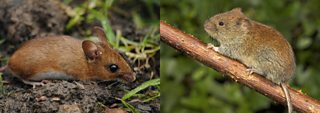Looking for signs of mammals on your doorstep
The Mammal Society
Partner organisation of the Watches
We may not have been able to stray far from our doorsteps this spring but there is still plenty to look for on your own patch.
Here are some signs of a few mammals to look out for in your garden…
One of Britain’s best loved mammals will be in the midst of courtship now. However, with the exception of individuals who have been disturbed from nests or mothers looking for extra food, you should not expect to see hedgehogs during the day. So, what are the ? You may spot distinctive sausage-shaped droppings, often with shiny fragments from eaten insects. They are usually 15-50 mm long and 8-10 mm thick. If you dare to sniff, they smell sweet - like linseed oil. Creating a is also a fun way of checking for hedgehogs, prints are around 28 by 25 mm.

Hedgehog dropping and footprints/Mammal Society
Seen from afar, mice tend to move in bounding jumps while voles scuttle. If you get closer, voles have smaller eyes and smaller, subtler ears – usually covered in fur. Mice have larger eyes and ears and longer tails in relation to their bodies. are much larger than either. You can also look for droppings. Rats’ are dark and foul-smelling, rice grain shaped with one blunt end and one slightly pointed – the size of a pound coin. Mice’s are also rice-shaped but smaller and usually both ends are pointed – vole droppings are usually both blunt-ended. Chewed nuts from hazel or cob-nut trees also provide clues. leave tooth marks on the nut surface and across the hole edge which may be circular or ragged in shape. create a round hole with tooth marks across the edge, but not on the nut surface. Meanwhile, rats and squirrels often split the entire nut open.

A wood mouse © Samuel Hood/Mammal Society (left) and bank vole © Gary Cox/Mammal Society (right)
Bats
A bat detector allows us to hear echolocation calls but if you don’t have one, there are still signs you can glean from a glimpse to help you form an idea of what species you’ve seen. Common and soprano pipistrelles are by far the most abundant species in Britain, frequently found in gardens and around houses. Look for small sparrow-sized bats flying around sunset between head and treetop height. Brown long-eared bats are also commonly found in houses, particularly with large roof-spaces, and also in trees. They come out much later than pipistrelles – usually waiting until it is almost dark. They are slightly larger than pipistrelles with very manoeuvrable, slow flight: easily weaving between trees. You may even spot the long ears! Much larger than pipistrelle or long-eared bats (look for bats about the size of a blackbird) and regularly seen from gardens, are noctules and serotines. Noctules fly very fast and have long thin wings. They fly high up, around the height of swallows and swifts and emerge early when still quite light. Serotine bats have broad wings and are often seen flying lower (tree-tops or below), making lots of dives and turns catching beetles.

Common pipistrelle © Mark Hows/Mammal Society (left); Brown long-eared bat © Daniel Hargreaves/Mamaml Society (centre); Noctule bat © Chris Damant/Mammal Society (right)
Record what you find!
Our free is a great way to record mammals and signs of mammals. All records are verified and go to the National Biodiversity Network and Biological Records Centre. Your sightings really help us to continue to understand the status of British mammals and how best to conserve them. We hope you enjoy searching for mammal signs not just of these but of , , and more!
